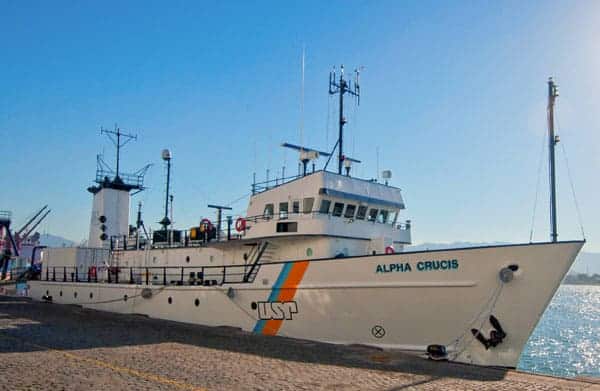Science equipment and underwater vehicles deployed from Brazil’s flagship oceanographic research vessel, Alpha Crucis, are to be tracked using Ultra-Short BaseLine (USBL) positioning technology supplied by Sonardyne Brasil Ltda.
The 64 m-long vessel, which is operated by the University of São Paulo, undertakes research projects spanning global climate change to biodiversity in Brazilian waters. It will be equipped with a Sonardyne Ranger 2 USBL high precision acoustic positioning system to enable the Alpha Crucis’ 21-strong science team to precisely track their instruments and sensors to beyond 7 km.
Ranger 2 accurately tracks the position of subsea targets by precisely measuring the range and bearing from a vessel-mounted transceiver to transponders on each target. The University of São Paulo has selected Sonardyne’s pre-calibrated Gyro USBL transceiver for the vessel and 4,000 m depth rated Wideband Sub-Mini 6 Plus (WSM 6+) transponders for its in-water equipment, which includes sediment corers, towed cameras, landers and remotely operated vehicles (ROV).
Gyro USBL is pre-calibrated thanks to its perfectly aligned acoustic transceiver and built-in attitude and heading reference sensor (AHRS). This combination eliminates the need for measurements to be undertaken to determine the alignment of the ship’s motion sensors to the acoustic transceiver. Survey operations are faster and more precise, helping to maximise the available vessel time for science.
[blockquote author=” Dr. Prof. Paulo Sumida, Vice-Dean, Oceanographic Institute of University of São Paulo”]”To gather meaningful data to support our studies, first our scientists need to know exactly where their sensors and equipment packages are in the ocean when they make their observations. With Ranger 2, they’ll be able to do just that. It came highly recommended by our colleagues in the international science community giving us every confidence to select it for the Alpha Crucis.”[/blockquote]
André Moura, Sales & Applications Manager from Sonardyne Brasil, says, “The university’s vessel operates from off the coast to the deepest parts of the South Atlantic so it’s important it’s equipped with the best available technologies available to underpin its important work. Ranger 2 Gyro USBL, deployed using our over-the-side deployment pole, is the perfect option for the vessel – it’s quick to install and pre-calibrated. Plus it gives the university the option to move the complete system to another vessel if the need ever arises.”
